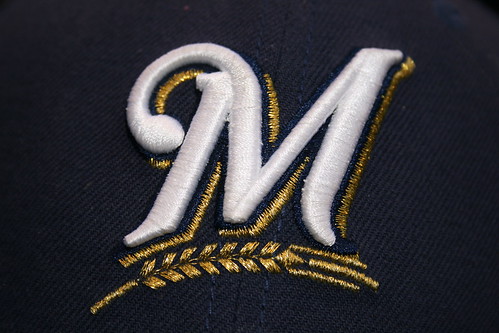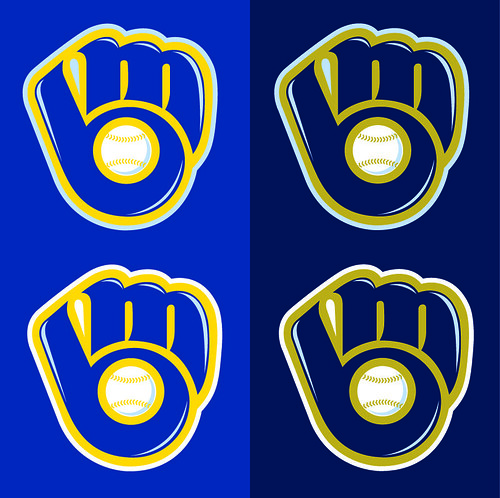The Cubs have not won the World Series in 103 years, a longer championship drought than that of any other major North American professional sports team, and are often referred to as "The Lovable Losers" because of this distinction. They are also known as "The North Siders" because Wrigley Field, their home park since 1916, is located in Chicago's north side Lake View community at 1060 West Addison Street. The Cubs have rivalries with the St. Louis Cardinals, the Milwaukee Brewers, the Houston Astros, and the cross-town White Sox.
The club played its first games in 1870 and was founded professionally in 1871. This makes it, along with the Braves who were also founded in 1871, one of the two oldest active teams in major North American sports. Because the Cubs lost two seasons to the Great Chicago Fire, the Braves have played more seasons, although the Cubs hold the record for oldest team still in its original city.
William Hulbert, president of Chicago's club, the White Stockings, signed multiple star players, such as pitcher Albert Spalding and infielders Ross Barnes, Deacon White, and Adrian "Cap" Anson, to join the team prior to the N.L.'s inaugural season of 1876. The Chicago franchise, playing its home games at West Side Grounds, quickly established itself as one of the new league's top teams. Spalding won 47 games and Barnes led the league in hitting at .429 as Chicago won the first ever National League pennant, which at the time was the game's top prize.
After back-to-back pennants in 1880 and '81, Hulbert died, and Spalding, who had retired to start Spalding sporting goods, assumed ownership of the club. The White Stockings, with Anson acting as player/manager, captured their third consecutive pennant in 1882, and Anson established himself as the game's first true superstar. In 1885 and '86, after winning N.L. pennants, the White Stockings met the short-lived American Association champion in that era's version of a World Series. Both seasons resulted in matchups with the St. Louis Brown Stockings, with the clubs tying in '85 and with St. Louis winning in '86. This was the genesis of what would eventually become one of the greatest rivalries in sports. In all, the Anson-led Chicago Base Ball Club won six National League pennants between 1876 and 1886. As a result, Chicago's club nickname transitioned, and by 1890 they had become known as the Chicago Colts, or sometimes "Anson's Colts," referring to Cap's influence within the club. Anson was the first player in history credited with collecting 3,000 career hits, and when he left the team in 1898, the loss of his leadership resulted in the team becoming known as the Chicago Orphans (or Remnants) and a few forgettable seasons.
After the 1900 season, the American Base-Ball League formed as a rival professional league, and incidentally the club's old White Stockings nickname would be adopted by a new American League neighbor to the south.
In 1902, Spalding, who by this time had revamped the roster to boast what would soon be one of the best teams of the early century, sold the club to Jim Hart, and the franchise became known as the Chicago Cubs. During this period, which has become known as baseball's dead-ball era, Cub infielders Joe Tinker, Johnny Evers, and Frank Chance were made famous as a double-play combination by Franklin P. Adams' poem Baseball's Sad Lexicon. The poem first appeared in the July 18, 1910 edition of the New York Evening Mail. Mordecai "Three-Finger" Brown, Jack Taylor, Ed Reulbach, Jack Pfiester, and Orval Overall were several key pitchers for the Cubs during this time period. With Chance acting as player-manager from 1905 to 1912, the Cubs won four pennants and two World Series titles over a five-year span. Although they fell to the "Hitless Wonders" White Sox in the 1906 World Series, the Cubs recorded a record 116 victories and the best winning percentage (.763) in Major League history. With mostly the same roster, Chicago won back-to-back World Series championships in 1907 and 1908. Their appearance in three consecutive World Series made the Cubs the first Major League club to play three times in the Fall Classic. Likewise, their back-to-back World Series victories in 1907 and 1908 made them the first club to win two World Series. However, the Cubs have not won a World Series since 1908; this remains the longest championship drought in North American professional sports.
The next season, veteran catcher Johnny Kling left the team to become a professional pocket billiards player. Some historians think Kling's absence was significant enough to prevent the Cubs from also winning a third straight title in 1909, as they finished 6 games out of first place. When Kling returned the next year, the Cubs won the pennant again, but lost to the Philadelphia Athletics in the 1910 World Series.
In 1914, advertising executive Albert Lasker obtained a large block of the club's shares and before the 1916 season assumed majority ownership of the franchise. Lasker brought in a wealthy partner, Charles Weeghman, the proprietor of a popular chain of lunch counters who had previously owned the Chicago Whales of the short-lived Federal League. As principal owners, the pair moved the club from the West Side Grounds to the much newer Weeghman Park, which had been constructed for the Whales only two years earlier. The Cubs responded by winning a pennant in the war-shortened season of 1918, where they played a part in another team's curse. The Boston Red Sox defeated Grover Cleveland Alexander's Cubs four games to two in the 1918 World Series. After the victory Boston's owner sold its star pitcher, Babe Ruth, to the New York Yankees to help funding of a Broadway play, and thus starting a tale of futility which would last 86 years, known as Curse of the Bambino. During what is often called baseball's "golden age", one of Cubs's minority owners, William Wrigley Jr., who also happened to be the owner of Wrigley Company, a Chicago-based maker of chewing gum, would begin to increase his share of ownership. Wrigley was responsible for the 1917 acquisition of astute baseball man William Veeck, Sr. to serve as Vice-President and Treasurer, and for later promoting Veeck to Club President in 1919. In 1921 Wrigley bought Weeghman's shares and by 1925 had acquired most of Lasker's shares as well. Wrigley then changed the name of Weeghman Park to its current name, Wrigley Field, in perhaps the earliest example of corporate naming rights. With Wrigley's vast monetary resources and Veeck's front-office savvy, the "double-Bills" soon had the Cubs back in business in the National League, building a team that would put numerous future Hall of Famers in Cub uniforms. Some of the most notable of these players were Hack Wilson, Gabby Hartnett, and Rogers Hornsby and thus Chicago remained strong contenders for the next decade. During the end of the first decade of the double-Bills' guidance, the Cubs won the NL pennant in 1929 and then achieved the unusual feat of winning a pennant every three years, following up the 1929 flag with league titles in 1932, 1935, and 1938. Unfortunately, their success did not extend to the Fall Classic, as they fell to their AL rivals each time. The '32 series against the Yankees featured Babe Ruth's "called shot" at Wrigley Field. There were some historic moments for the Cubs as well; they claimed the '35 pennant in thrilling fashion, winning a record 21 games in a row in September. The '38 club saw Dizzy Dean lead the team's pitching staff and provided a historic moment when they won a crucial late-season game at Wrigley Field over the Pittsburgh Pirates with a walk-off home run by Gabby Hartnett, which became known in baseball lore as "The Homer in the Gloamin'". By 1939, the "double-Bills" (Wrigley and Veeck) had both died, and the front office, now under P.K. Wrigley, found itself unable to rekindle the kind of success that P.K.'s father had created, and so the team slipped into years of mediocrity.
The club played its first games in 1870 and was founded professionally in 1871. This makes it, along with the Braves who were also founded in 1871, one of the two oldest active teams in major North American sports. Because the Cubs lost two seasons to the Great Chicago Fire, the Braves have played more seasons, although the Cubs hold the record for oldest team still in its original city.
William Hulbert, president of Chicago's club, the White Stockings, signed multiple star players, such as pitcher Albert Spalding and infielders Ross Barnes, Deacon White, and Adrian "Cap" Anson, to join the team prior to the N.L.'s inaugural season of 1876. The Chicago franchise, playing its home games at West Side Grounds, quickly established itself as one of the new league's top teams. Spalding won 47 games and Barnes led the league in hitting at .429 as Chicago won the first ever National League pennant, which at the time was the game's top prize.
After back-to-back pennants in 1880 and '81, Hulbert died, and Spalding, who had retired to start Spalding sporting goods, assumed ownership of the club. The White Stockings, with Anson acting as player/manager, captured their third consecutive pennant in 1882, and Anson established himself as the game's first true superstar. In 1885 and '86, after winning N.L. pennants, the White Stockings met the short-lived American Association champion in that era's version of a World Series. Both seasons resulted in matchups with the St. Louis Brown Stockings, with the clubs tying in '85 and with St. Louis winning in '86. This was the genesis of what would eventually become one of the greatest rivalries in sports. In all, the Anson-led Chicago Base Ball Club won six National League pennants between 1876 and 1886. As a result, Chicago's club nickname transitioned, and by 1890 they had become known as the Chicago Colts, or sometimes "Anson's Colts," referring to Cap's influence within the club. Anson was the first player in history credited with collecting 3,000 career hits, and when he left the team in 1898, the loss of his leadership resulted in the team becoming known as the Chicago Orphans (or Remnants) and a few forgettable seasons.
 Milwaukee Brewers Logo |  Milwaukee Brewers Logo |  Milwaukee Brewers Classic Logo |  Milwaukee Brewers Logo - Chris |  Milwaukee Brewers Logo |
 Milwaukee Brewers logo pic |  Milwaukee Brewers Logo - Chris |  Milwaukee Brewers Logo |  Milwaukee Brewers Logo | Fathead Milwaukee Brewers Logo |
The next season, veteran catcher Johnny Kling left the team to become a professional pocket billiards player. Some historians think Kling's absence was significant enough to prevent the Cubs from also winning a third straight title in 1909, as they finished 6 games out of first place. When Kling returned the next year, the Cubs won the pennant again, but lost to the Philadelphia Athletics in the 1910 World Series.
 Milwaukee Brewers Retro |  Milwaukee Brewers logo | Logo vector Brewers Milw logo |  MLB Milwaukee Brewers Foil | Milwaukee Brewers |
 Milwaukee Brewers Secondary |  Milwaukee Brewers Logo |  Milwaukee Brewers Logo 3 |  Winston Churchill Painting Up |  to Sir Winston Churchill, |
No comments:
Post a Comment